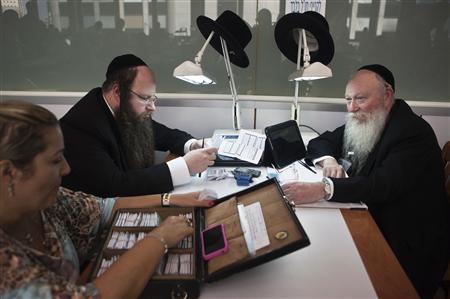Dateline Jerusalem — When my daughter was 7 years old, she screamed when she found out that the diamond in my ring was temporarily missing from its setting. Her father came running to find out what happened. She explained, “Daddy, don’t you know? A diamond is a girl’s best friend.” After visiting the Harry Oppenheimer Diamond Museum in the heart of the Israeli Diamond District, also known as the Israel Diamond Exchange, in Ramat Gan this week, I fully understood the allure of the diamond and why I had taught my daughter its value so long ago. Not only are diamonds a woman’s best friend, but according to the diamond industry, diamonds are man’s greatest passion.
The Israel Diamond Exchange, on the outskirts of Tel Aviv in Ramat Gan, occupies five interconnected high-rise office towers with 1,000 offices where manufacturers, brokers, traders, exporters and buyers meet and negotiate the price of diamonds. It has a reputation for being the most technologically-advanced and one of the largest diamond exchanges in the world. Half of all traded diamonds in the world pass through Israel. Yet Israel has no mined diamonds of its own. At the beginning of the State of Israel, the diamond industry accounted for half of the country’s industrial exports. Now it is only 24 percent of exports. Yet people from all over the world come to the Israel Diamond Exchange. Whatever their background, ethnicity and language, a diamond deal always is sealed by a handshake and the Hebrew words “mazal u’braha,” meaning “good fortune and a blessing.” Not only Israelis, but foreigners say the words to show their commitment to the deal.
Jews have been major players with respect to diamonds. In the 15th century a Jewish diamond cutter invented the scaif, and thereafter, diamond cutting became a traditional Jewish craft passed down from father to son. Not only are Jews involved in diamond cutting, but Israelis are in state of the art diamond polishing. At the beginning of this century, Israel was one of the world’s three major centers for polished diamonds, along with India and Belgium. The U.S. leads the world as the largest export market for polished diamonds. Hong Kong is a close second.
Taking Precaution
Israel was the first country in the world to accept the Kimberly Process, a joint government and international diamond industry initiative. It was instituted to prevent the shipment of conflict diamonds from entering into the legitimate trade of diamonds. Conflict diamonds are rough diamonds used by rebels to finance wars against legitimate governments. The 45 participants in the Kimberly Process account for 99.8 percent of the global production of rough diamonds. Every shipment of conflict-free rough diamonds is certified by a Kimberly Process Certification Scheme. In addition, the participants can only trade with other participants in the Process which has stringent controls and requirements.
Diamonds, the hardest substances in nature, are classified by the four c’s: Color, clarity, cut and carat. They are valued accordingly. Although diamonds are not really rare as compared to some other gemstones, only 20 percent of all mined diamonds have a clarity rating high enough for use as a gemstone. The other 80 percent are used for industrial purposes. Of the 20 percent, so many have inclusions, imperfections and flaws, that a diamond with fewer imperfections becomes indeed rare and valuable.
Examples of rare and/or expensive diamonds include the Pink Star Diamond, mined in South Africa in 1999. It weighed 59.6 carats and sold at Sotheby’s auction for $83 million, more than any other diamond or gem ever sold. Red diamonds are very rare. Only a few ever have been found. The Argyle Mine in Australia produces a few and the largest auctioned sold for millions of dollars. A red diamond goes for $2.5 million per carat. Once the largest diamond in the world, the Koh-I-Noor diamond was 106 carats. It belonged to various rulers in India, but today it is part of the British royal family’s Crown Jewels. A flawless blue diamond sells for 10 times the per-carat price of regular white diamonds.
In 2010, an authenticated natural diamond with the design of a Star of David “cloud” was discovered. Cloud describes internal inclusions or defects in a diamond that affect clarity and often reduce its value. In this diamond the cloud formed the shape of two inverted equilateral triangles superimposed over each other which created the shape of a Star of David. The Star of David, also known as the Shield of David or Magen David in Hebrew, has Kabbalah significance. The six-pointed star represents the six days of Creation before the Sabbath. It is a symbol of the Jewish people and appears on Israel’s flag. The Star of David Diamond went on display at the Oppenheimer Diamond Museum this year in honor of the 68th anniversary of the State of Israel.
A diamond is a girl’s best friend, as the entire world seems to realize. Israel plays a major role in the diamond industry.
L’hitraot. Shachar








